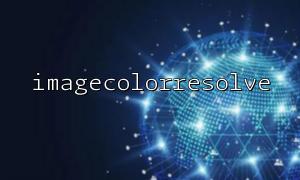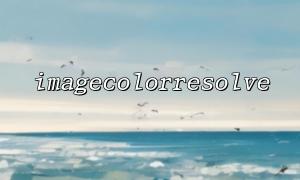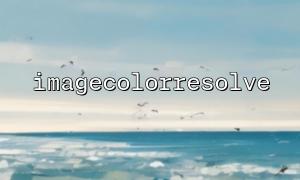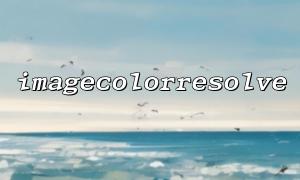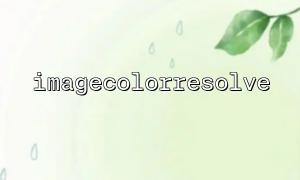In PHP image processing, we often encounter situations where we need to resolve colors. To accurately find or generate colors on an image, PHP provides some functions to help us achieve these tasks. Among them, imagecolorresolve(), imagecolorexact(), and imagecolorclosest() are three commonly used functions. So, what are the differences between these three, and how do we choose the most appropriate one? We will analyze the differences in detail and discuss their practical usage scenarios.
imagecolorresolve() is used to find the closest color in the image's palette based on the given RGB values. If the image uses a palette (such as GIF images or PNG images with palettes), this function looks for the closest color in the palette.
imagecolorresolve($image, $r, $g, $b);
$image: The image resource, usually created by functions like imagecreatefrom*().
$r: The red value to find.
$g: The green value to find.
$b: The blue value to find.
$image = imagecreatefrompng('example.png');
$index = imagecolorresolve($image, 255, 0, 0); // Find the closest color to red
imagecolorresolve() returns the index of the color in the palette closest to the given RGB value. If it cannot find one, it returns -1.
imagecolorexact() searches for a color that exactly matches the specified RGB values. If the exact color exists in the image's palette, it returns its index. If no exact match is found, it returns -1.
imagecolorexact($image, $r, $g, $b);
$image: The image resource.
$r, $g, $b: The specified red, green, and blue values.
$image = imagecreatefrompng('example.png');
$index = imagecolorexact($image, 255, 0, 0); // Find the exact match to red
If the image palette contains an exact matching color, imagecolorexact() returns the index of that color. Otherwise, it returns -1.
imagecolorclosest() is similar to imagecolorresolve() in that it searches for the closest color to the specified color in the palette. However, unlike imagecolorresolve(), imagecolorclosest() can handle color modes beyond palettes, such as 24-bit true color images.
imagecolorclosest($image, $r, $g, $b);
$image: The image resource.
$r, $g, $b: The specified red, green, and blue values.
$image = imagecreatefrompng('example.png');
$index = imagecolorclosest($image, 255, 0, 0); // Find the closest color to red
imagecolorclosest() returns the index of the color closest to the specified color, suitable for non-palette images.
| Function Name | Purpose | Return Value |
|---|---|---|
| imagecolorresolve() | Finds the palette color closest to the specified RGB value | Returns the color index, or -1 if not found |
| imagecolorexact() | Finds the palette color that exactly matches the specified RGB value | Returns the color index, or -1 if not found |
| imagecolorclosest() | Finds the color closest to the specified RGB value, supports non-palette images (e.g., true color images) | Returns the color index, or -1 if not found |
If you need to find the closest color to a specified RGB value in a palette-based image and don’t require an exact match, use imagecolorresolve(). It is suitable for GIFs, indexed PNGs, and other palette-based images.
If you only want to find an exact color in the palette and prefer to do nothing if there is no exact match, use imagecolorexact(). This function fits scenarios with strict color accuracy requirements but requires that the exact color exists in the image.
If you are working with non-palette images (such as true color images) or want to find the closest color in any type of image, imagecolorclosest() is more suitable. It supports 24-bit true color images and can find the nearest color effectively.
If you are working with palette-based images, both imagecolorresolve() and imagecolorexact() are options. The former is more lenient, while the latter requires an exact match.
For non-palette images or when you want to find the closest color, imagecolorclosest() is more flexible and applicable.
Choosing the most suitable function based on your image type and requirements will help you handle color issues more effectively in image processing.

